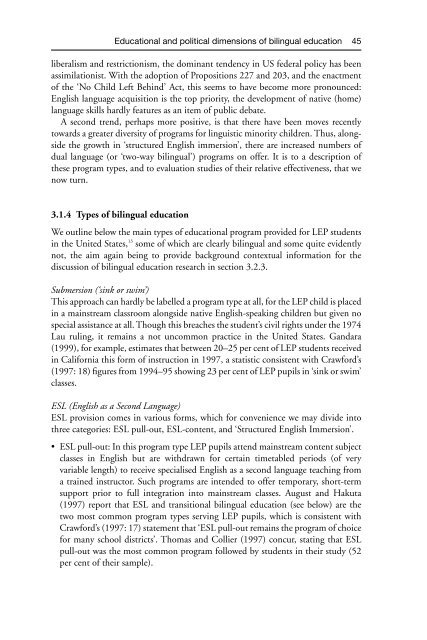Gibson Ferguson Language Planning and Education Edinburgh ...
Gibson Ferguson Language Planning and Education Edinburgh ...
Gibson Ferguson Language Planning and Education Edinburgh ...
Create successful ePaper yourself
Turn your PDF publications into a flip-book with our unique Google optimized e-Paper software.
<strong>Education</strong>al <strong>and</strong> political dimensions of bilingual education 45<br />
liberalism <strong>and</strong> restrictionism, the dominant tendency in US federal policy has been<br />
assimilationist. With the adoption of Propositions 227 <strong>and</strong> 203, <strong>and</strong> the enactment<br />
of the ‘No Child Left Behind’ Act, this seems to have become more pronounced:<br />
English language acquisition is the top priority, the development of native (home)<br />
language skills hardly features as an item of public debate.<br />
A second trend, perhaps more positive, is that there have been moves recently<br />
towards a greater diversity of programs for linguistic minority children. Thus, alongside<br />
the growth in ‘structured English immersion’, there are increased numbers of<br />
dual language (or ‘two-way bilingual’) programs on offer. It is to a description of<br />
these program types, <strong>and</strong> to evaluation studies of their relative effectiveness, that we<br />
now turn.<br />
3.1.4 Types of bilingual education<br />
We outline below the main types of educational program provided for LEP students<br />
in the United States, 13 some of which are clearly bilingual <strong>and</strong> some quite evidently<br />
not, the aim again being to provide background contextual information for the<br />
discussion of bilingual education research in section 3.2.3.<br />
Submersion (‘sink or swim’)<br />
This approach can hardly be labelled a program type at all, for the LEP child is placed<br />
in a mainstream classroom alongside native English-speaking children but given no<br />
special assistance at all. Though this breaches the student’s civil rights under the 1974<br />
Lau ruling, it remains a not uncommon practice in the United States. G<strong>and</strong>ara<br />
(1999), for example, estimates that between 20–25 per cent of LEP students received<br />
in California this form of instruction in 1997, a statistic consistent with Crawford’s<br />
(1997: 18) figures from 1994–95 showing 23 per cent of LEP pupils in ‘sink or swim’<br />
classes.<br />
ESL (English as a Second <strong>Language</strong>)<br />
ESL provision comes in various forms, which for convenience we may divide into<br />
three categories: ESL pull-out, ESL-content, <strong>and</strong> ‘Structured English Immersion’.<br />
• ESL pull-out: In this program type LEP pupils attend mainstream content subject<br />
classes in English but are withdrawn for certain timetabled periods (of very<br />
variable length) to receive specialised English as a second language teaching from<br />
a trained instructor. Such programs are intended to offer temporary, short-term<br />
support prior to full integration into mainstream classes. August <strong>and</strong> Hakuta<br />
(1997) report that ESL <strong>and</strong> transitional bilingual education (see below) are the<br />
two most common program types serving LEP pupils, which is consistent with<br />
Crawford’s (1997: 17) statement that ‘ESL pull-out remains the program of choice<br />
for many school districts’. Thomas <strong>and</strong> Collier (1997) concur, stating that ESL<br />
pull-out was the most common program followed by students in their study (52<br />
per cent of their sample).






